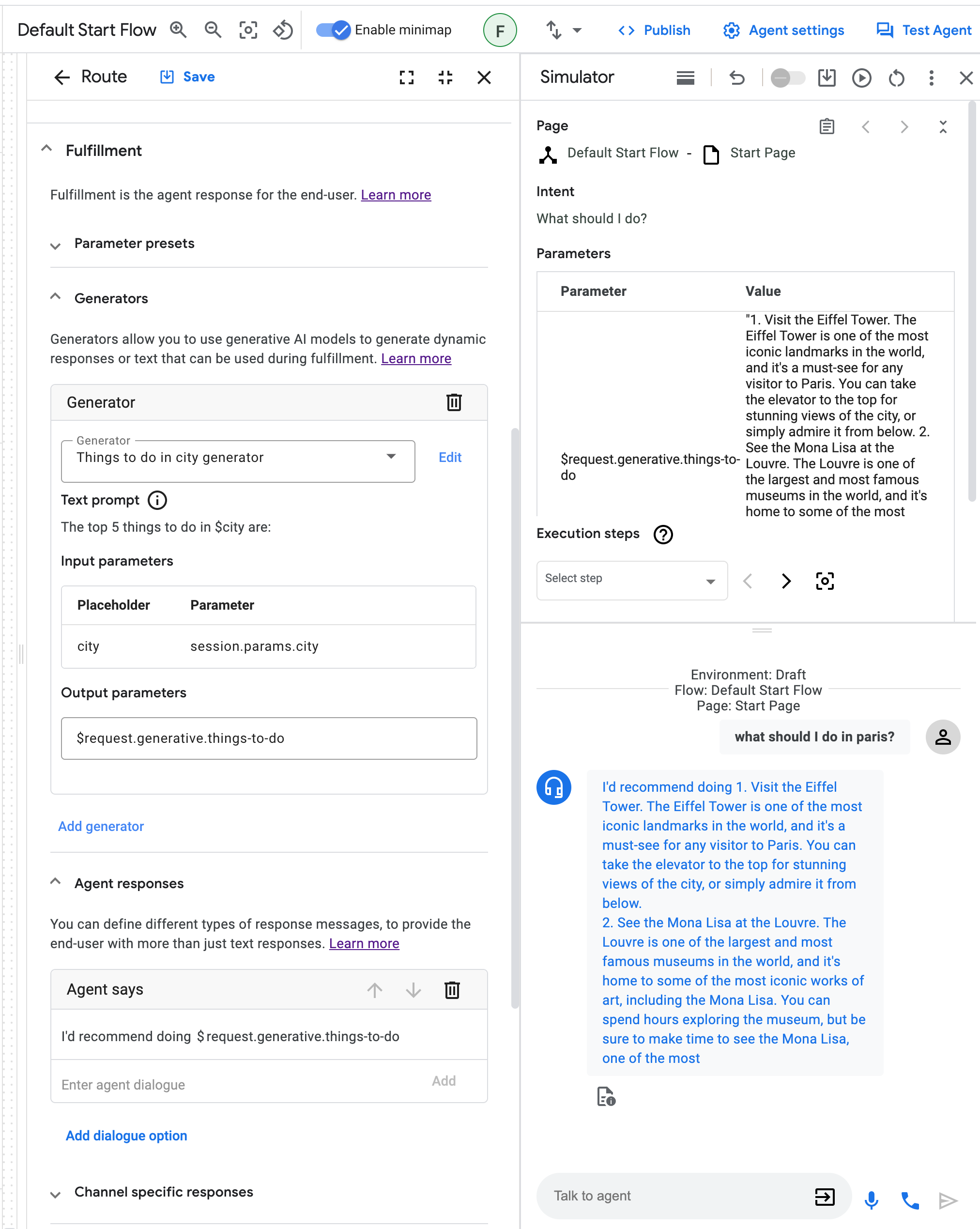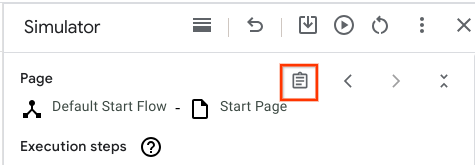生成器使用 Google 最新的生成式大语言模型 (LLM) 和您提供的提示,在运行时生成智能体行为和回答。可用模型由 Vertex AI 提供。
借助生成器,您可以从 Conversational Agents (Dialogflow CX) 原生调用 LLM,而无需创建自己的外部 webhook。您可以将生成器配置为执行您通常要求 LLM 执行的任何操作。
生成器非常适合执行总结、参数提取、数据转换等任务,请参阅下面的示例。
限制
此功能适用于任何 Dialogflow 语言的客服人员,但可用的模型可能存在更严格的语言限制。如需了解详情,请参阅 Vertex AI。
了解生成器概念
Vertex AI 文档包含一些在为 Dialogflow 创建生成器时需要了解的重要信息:
定义生成器
如需创建生成器,请执行以下操作:
- 前往 Dialogflow CX 控制台。
- 选择您的 Google Cloud 项目。
- 选择代理。
- 点击管理标签页。
- 点击生成器。
- 点击新建 (Create new)。
- 为生成器输入描述性显示名称。
- 输入文本提示、模型和控件,如概念中所述。
- 点击保存。
在运行时执行过程中,系统会将文本提示发送到生成式模型。问题或请求应明确,以便模型生成令人满意的回答。
您可以通过在字词前面添加 $ 来将字词标记为占位符,从而使提示具有上下文。您稍后可以在执行中将这些生成器提示占位符与会话参数相关联,它们会在执行期间替换为会话参数值。

有一些特殊的生成器提示占位符,无需与会话参数相关联。这些内置生成器提示占位符是
| 术语 | 定义 |
|---|---|
$conversation |
代理与用户之间的对话,不包括最后一句用户语音和之后的代理语音。 |
$last-user-utterance |
最后一次用户语音指令。 |
在执行方式中使用生成器
您可以在执行期间使用生成器(在路由、事件处理脚本、参数等中)。
前往执行窗格的 Generators(生成器)部分,然后将其展开。 然后,点击添加发电机。现在,您可以选择预定义的生成器,也可以就地定义新的生成器。
选择生成器后,您需要将该生成器的生成器提示占位符与会话参数相关联。为此,您需要定义一个输出参数,该参数将包含生成器在执行后生成的结果。在输出参数字段中,为输出参数输入名称,例如 things-to-do。此输出参数将写入一个会话参数,以供您日后引用。
然后,您可以稍后使用输出参数引用生成器结果,例如在代理响应中:I'd recommend doing $session.params.things-to-do。
如需详细了解参数格式和用法,请参阅参数文档。
测试生成器
您可以在模拟器中直接测试生成器功能。

示例
本部分提供了生成器的示例用例。由于生成器是一种基于大语言模型 (LLM) 的生成式技术,因此您使用以下示例提示获得的个别结果可能会与此处记录的输出不同。Google 返回的所有提示结果均是尽力提供的。
内容总结
此示例展示了如何总结内容。
提示:
Your goal is to summarize a given text.
Text:
$text
A concise summary of the text in 1 or 2 sentences is:
对话摘要
以下示例展示了如何提供对话摘要。
提示:
You are an expert at summarizing conversations between a User and an Agent.
When providing the summary, always start with "Dear $email_address, the conversation summary is as follows:"
Provide a summary in a few bullet points.
Try to be as brief as possible with each bullet point,
only noting the key points of the conversation.
Output the summary in markdown format.
Conversation:
$conversation
Summary:
已解决的提示:
在示例对话中,发送到生成式模型的解析后的提示可能是:
You are an expert at summarizing conversations between a User and an Agent.
When providing the summary, always start with "Dear joe@example.com conversation summary is as follows:"
Provide a summary in a few bullet points.
Try to be as brief as possible with each bullet point,
only noting the key points of the conversation.
Output the summary in markdown format.
Conversation:
Agent: Good day! What can I do for you today?
User: Hi, which models can I use in Conversational Agents (Dialogflow CX)'s generators?
Agent: You can use all models that Vertex AI provides!
User: Thanks, thats amazing!
Summary:
Markdown 格式
以下示例展示了如何使用 Markdown 设置文本格式。
# Instructions
You are presented with a text and your goal is to apply markdown formatting to text.
**NOTE:** Do not change the meaning of the text, only the formatting.
# Example
## Text
Generators allow you to use Googles latest generative models to format text,
or to create a summaries, or even to write code. What an amazing feature.
## Text in Markdown
*Generators* allow you to use Google's latest generative models to
* format text
* create a summaries
* write code
What an amazing feature.
# Your current task
## Text
$text
## Text in Markdown
问答
下面的一系列示例展示了如何使用生成器回答问题。
首先,您可以仅依靠生成式模型的内部知识来回答问题。不过请注意,模型只会根据其训练数据中的信息提供回答。我们无法保证回答是正确或最新的。
使用自知识提示回答问题
Your goal is to politely reply to a human with an answer to their question.
The human asked:
$last-user-utterance
You answer:
使用提供的信息提示问答
不过,如果您希望模型根据您提供的信息进行回答,只需将相应信息添加到问题中即可。如果您要提供的信息不多(例如小型餐厅菜单或贵公司的联系信息),这种方法就很适用。
# Instructions
Your goal is to politely answer questions about the restaurant menu.
If you cannot answer the question because it's not related to the restaurant
menu or because relevant information is missing from the menu, you politely
decline to answer.
# Restaurant menu:
## Starters
Salat 5$
## Main dishes
Pizza 10$
## Desserts
Ice cream 2$
# Examples
Question: How much is the pizza?
Answer: The pizza is 10$.
Question: I want to order the ice cream.
Answer: We do have ice cream! However, I can only answer questions about the menu.
Question: Do you have spaghetti?
Answer: I'm sorry, we do not have spaghetti on the menu.
# Your current task
Question: $last-user-utterance
Answer:
使用动态提供的信息提示问答
通常,您希望模型根据的信息太多,无法直接粘贴到问题中。在这种情况下,您可以将生成器连接到信息检索系统(例如数据库或搜索引擎),以便根据查询动态检索信息。您只需将该系统的输出保存到参数中,并将其连接到提示中的占位符即可。
# Instructions
Your goal is to politely answer questions based on the provided information.
If you can't answer the question given the provided information, you politely
decline to answer.
# Provided information:
$information
Question: $last-user-utterance
Answer:
代码生成
此示例展示了如何使用生成器编写代码!请注意,在此处,使用专门训练来生成代码的生成模型是合理的。
提示
# Instructions:
Your goal is to write code in a given programming language solving a given problem.
Problem to solve:
$problem
Programming language:
$programming-language
# Solution:
上报给人工客服
此示例展示了如何处理上报给人工客服的情况。提示中的最后两个说明可防止模型过于详尽。
提示:
# Instructions:
You are a polite customer service agent that handles requests
from users to speak with an operator.
Based on the $last-user-utterance,
respond to the user appropriately about their request to speak with an operator.
Always be polite and assure the user that you
will do your best to help their situation.
Do not ask the user any questions.
Do not ask the user if there is anything you can do to help them.
# Answer:
搜索查询生成
此示例展示了如何优化用户提供的 Google 搜索查询。
提示:
# Instructions:
You are an expert at Google Search and using "Google Fu"
to build concise search terms that provide the highest quality results.
A user will provide an example query,
and you will attempt to optimize this to be the best Google Search query possible.
# Example:
User: when was covid-19 first started and where did it originated from?
Agent: covid-19 start origin
# Your task:
User: $text
Agent:
检索客户信息
此示例展示了如何执行信息检索以及搜索以字符串或 JSON 格式提供的数据。Dialogflow 会话参数通常使用这些格式。
提示:
You are a database engineer and specialize in extracting information
from both structured and unstructured data formats like CSV, SQL, JSON,
and also plain text.
Given a $user_db, extract the information requested
by the user from the $last-user-utterance
EXAMPLE:
user_db: {'customer_name': 'Patrick', 'balance': '100'}
User: What is my current account balance?
Agent: Your current balance is 100.
Begin!
user_db: $user_db
User: $last-user-utterance
Agent:
更新 JSON 对象
此示例展示了如何接受来自用户(或 webhook)的输入 JSON 对象,然后根据用户的请求操控该对象。
提示:
You are an expert Software Engineer
that specializes in the JSON object data structure.
Given some user $update_request and existing $json_object,
you will modify the $json_object based on the user's $update_request.
EXAMPLE:
json_object = { "a": 1, "b": 123 }
User: Add a new key/value pair to my JSON
Agent: What do you want to add?
User: c: cat
Agent: { "a": 1, "b": 123, "c": "cat"}
json_object = {"accounts": [{"username": "user1", "account_number": 12345}, {"username": "user2", "account_number": 98765}], "timestamp": "2023-05-25", "version":"1.0"}
User: Add a new value for user1
Agent: What do you want to add?
User: birthday, 12/05/1982
Agent: {"accounts": [{"username": "user1", "account_number": 12345, "birthday": "12/05/1982"}, {"username": "user2", "account_number": 98765}], "timestamp": "2023-05-25", "version":"1.0"}
json_object = $json_object
User: Add a new key value to my db
Agent: What do you want to add?
User: $last-user-utterance
Agent:
Codelab
另请参阅生成器 Codelab。
问题排查
如果您想调试此功能,可以在 Dialogflow 控制台模拟器中检查已解析的大语言模型 (LLM) 输入提示:
点击原始回答按钮:

找到 “Generators LLM Inputs” 字段。将这些字段作为纯文本读取,并检查 LLM 输入是否合理。如果任何短语包含
$,请检查模拟器输入,并明确提示中的$是否是故意添加的(例如,price is $10中的$可能是故意添加的,而visit $city中的$可能不是,可能暗示了用法错误或 bug)。如果您没有看到“生成式 LLM 输入”字段,请与支持团队联系。

